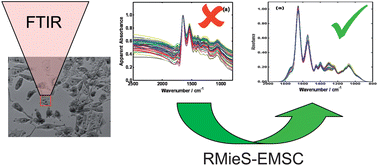Resonant Mie Scattering (RMieS) correction of infrared spectra from highly scattering biological samples
Abstract

* Corresponding authors
a
School of Chemical Engineering and Analytical Science, Manchester Interdisciplinary Biocentre, University of Manchester, 131 Princess Street, Manchester, UK
E-mail:
Peter.gardner@manchester.ac.uk
Fax: +44 (0) 161 306 5201
Tel: +44 (0) 161 306 4463
b Nofima Mat, Centre for Biospectroscopy and Data Modelling, Ås, Osloveien 1, Norway
c CIGENE, Department of Mathematical Sciences and Technology, Norwegian University of Life Sciences, Norway
d Focas Research Institute, Dublin Institute of Technology, Kevin Street, Dublin 8, Ireland
e Synchrotron SOLEIL, L'Orme des Merisiers, BP48 - Saint Aubin, Gif-sur-Yvette Cedex, France
f Genito Urinary Cancer Research Group, School of Cancer, Enabling Sciences and Technology, Paterson Institute for Cancer Research, The University of Manchester, Manchester Academic Health Science Centre, The Christie NHS Foundation Trust, Manchester, UK
g Department of Urology, The Christie NHS Foundation Trust, Manchester, UK
h Department of Urology, Salford Royal NHS Foundation Trust, Salford, UK

 Please wait while we load your content...
Something went wrong. Try again?
Please wait while we load your content...
Something went wrong. Try again?
P. Bassan, A. Kohler, H. Martens, J. Lee, H. J. Byrne, P. Dumas, E. Gazi, M. Brown, N. Clarke and P. Gardner, Analyst, 2010, 135, 268 DOI: 10.1039/B921056C
To request permission to reproduce material from this article, please go to the Copyright Clearance Center request page.
If you are an author contributing to an RSC publication, you do not need to request permission provided correct acknowledgement is given.
If you are the author of this article, you do not need to request permission to reproduce figures and diagrams provided correct acknowledgement is given. If you want to reproduce the whole article in a third-party publication (excluding your thesis/dissertation for which permission is not required) please go to the Copyright Clearance Center request page.
Read more about how to correctly acknowledge RSC content.
 Fetching data from CrossRef.
Fetching data from CrossRef.
This may take some time to load.
Loading related content
